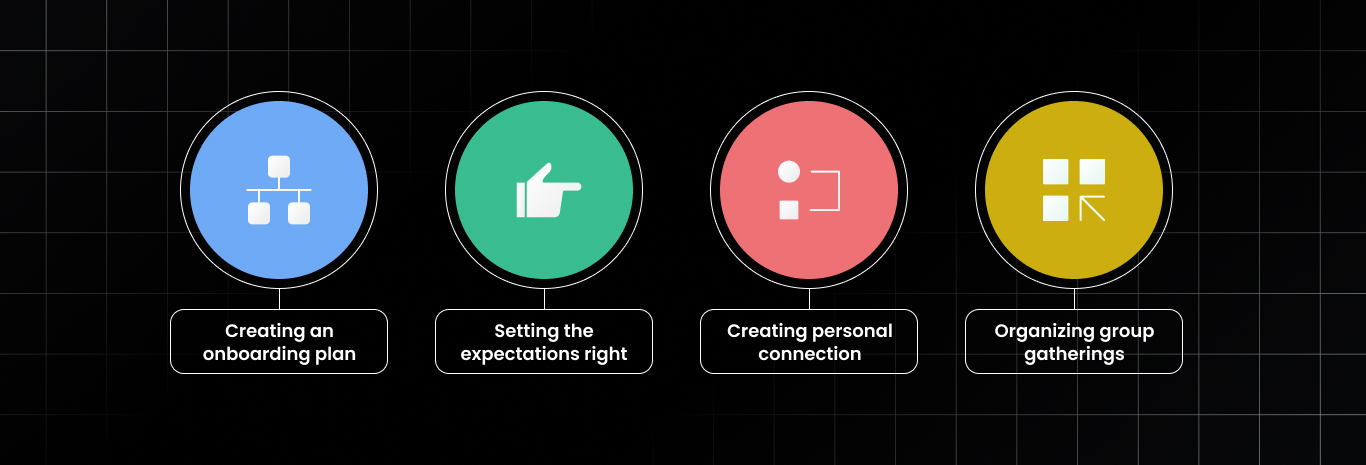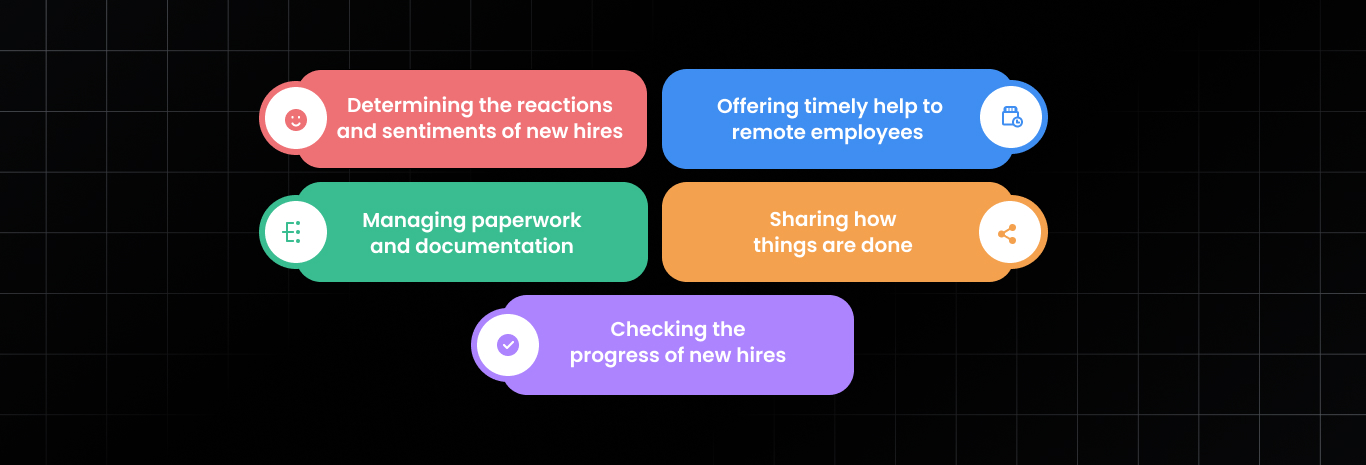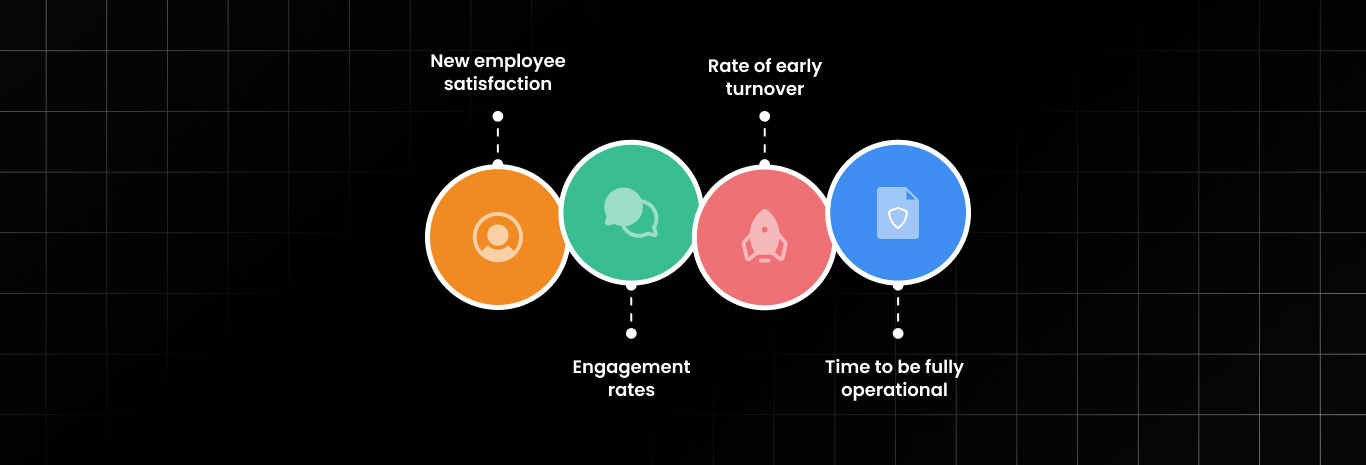Remote onboarding was an alien concept for most organizations before March 2020. But as its impact intensified, the search for “virtual onboarding” increased four times in July 2020 compared to January 2020. And it has become unavoidable ever since.
The hybrid work model also gained prominence as more people got vaccinated and travel bans got lifted. A Mercer study found that 70% of the companies were planning to shift to a hybrid work model. However, the PWC report indicated that more than 50% of the surveyed employees want to work remotely even after the pandemic.
As a result of the distributed work environment, onboarding new employees has become a hassle for organizations since then. Read this blog to explore remote onboarding challenges that HRs and employees face and how you can overcome these with tech solutions.
What aspects of remote onboarding should you keep in mind?

Employee onboarding is a process or a series of activities that help new hires learn about company culture, mission and values, their role, colleagues, team, and managers. It is known as remote onboarding if you onboard new hires virtually.
The challenge with remote onboarding is that you can not jump into cubicles to check on new hires to see how well they are adjusting to their role. You need to work on the trust factor from day one and use creative ways to build a relationship where the new hires don’t hesitate to ask questions.
Here are some aspects of remote onboarding that you must keep in mind:
Creating an onboarding plan
A clear onboarding plan ensures that the newly hired remote employees stay with you. While making the onboarding plan, you need to think of everything your new hires will need from you. And vice versa.
You don’t want your employees sending emails regarding document submission on day one. Therefore, your remote onboarding plan should ensure that all the formalities are complete before their joining date. Having a plan will help you start strong with preboarding.
It will also help you set milestones to measure your remote hires’ progress. If they are stuck, the managers can help them move forward. The onboarding plan should also include tasks for managers like orientation, introduction, briefing remote employees about projects, etc.
Setting the expectations right
Your remote employees should know what you expect from them from the beginning. It gives them clarity about their responsibilities and helps them keep track of their progress on the tasks assigned.
When onboarding remote employees, avoid micromanaging them. Because when you micro-manage the new hires, they might feel you are limiting their creativity.
These new hires learn many things in the initial few weeks or months. Giving them a free pass in their initial days is good practice. How you supervise them without micromanaging sets the foundation for their future work.
Creating personal connection
In a traditional hiring setup, you give office tours, initiate team introductions, go for team lunches, and do many things that build a personal connection. But these things are impossible in a remote setting (or at least they don’t have the same feeling).
To avoid making remote employees feel constricted or left out, ensure that you assign them a welcome buddy. The onboarding buddy should be their go-to person for all queries and guidance. It will help new hires acclimate faster into the team and the organization.
Organizing group gatherings
If you can arrange an in-person gathering for your remote hires, do it. Nothing addresses the isolation issue better than in-person gatherings.
However, in most cases, it’s impossible to arrange an in-person meetup because of the budget and diverse location of remote employees. If that is the case, you can efficiently conduct a virtual gathering.
In these virtual gatherings, your new remote employees will get to know the individuals they will be working with. It will create a sense of belonging in them.
What are the challenges of remote onboarding for employees?

Here are some of the challenges that employees face during their virtual onboarding:
Setting up the tech
When employees start an in-office job, they have all the equipment on their desks to get started with the job. And in case of any technical issue, they can call someone from the tech team and get it solved in no time.
But in remote onboarding, things are a bit challenging. Firstly, they have to wait for the equipment to get delivered to their location. Then, they have to set it up and ensure it works fine on day 1 of joining. Besides setting up devices, they have to log in using company email, get access to project management tools, install software, set up an office at home, etc.
Feeling isolated from the team
According to Nicholas Bloom’s (Stanford Professor) study, remote employees report loneliness and isolation as two of their biggest concerns. After all, remote workers, unlike in-office employees, can not go to the coffee machine or lunch to catch up with their colleagues. They miss out on small talk and little interactions. As a result, their productivity drops, and they feel hesitant to ask questions.
Virtual communication is a hassle
Virtual communication is one of the biggest challenges for remote employees as they have to figure out the platform that people use most in the organization. With different communication mediums available, such as email, slack, video conferencing, calling, etc., it really becomes difficult for the employees to figure out. And it doesn’t end here; employees also need to check if it’s the right time to reach out to someone for help. It is a lot of work for a problem that can be very simple.
Getting swamped with new information
In the initial days, remote hires receive an overwhelming volume of information for reading and learning. There is always someone to guide in-office employees. They get a brief from their colleagues, so they do not have to read the whole document.
But in the case of remote employees, they have to decide what to read and when on their own. They get swamped with new information, which makes their onboarding process challenging.
Challenges of remote onboarding for HRs

Virtual onboarding is equally challenging for HRs as it is for remote employees. Much planning goes into creating a perfect and hassle-free process to save the time and energy of the concerned parties.
Here are some of the challenges faced by HRs:
Managing paperwork and documentation
Employee onboarding involves a lot of paperwork — contracts, benefits, resources, and more. HRs receive these documents in their email and upload them to the human resource management system. It is a tedious task that HRs have to do regularly.
Things are even worse in the case of remote onboarding. Remote employees sometimes forget to send some documents, and HRs have to contact them again for missed documents. It elongates the documentation process.
Determining the reactions and sentiments of new hires
When onboarding remotely, it is not possible for HRs to monitor employee reactions and sentiments. Due to this, the HRs cannot determine the engagement level of remote employees.
When they can not determine the engagement level, HRs fail to take the correct steps to stop the talent from drifting away, resulting in a high attrition rate.
Offering timely help to remote employees
During the onboarding process, HRs remain super busy. Every new hire reaches out to them with queries and doubts. When many employees reach out to them at once, some employees do not get timely help.
Moreover, remote employees contact HRs via email or messaging tools that they often miss due to a lot of administrative tasks.
Sharing how things are done
In remote onboarding, peer-to-peer interaction is limited. Because of low interaction, employees do not get valuable information from their colleagues.
Given this, HRs and managers step up to help employees understand how basic things work in the company. Though, it takes a toll on HRs’ bandwidth.
Checking the progress of new hires
During the pandemic, almost everyone worked remotely. And most companies did not have any tool to help them measure their remote employees’ progress. HRs could not determine how well the new hires adjust to the company.
But with AI-powered remote onboarding solutions by Leena AI, you can eliminate all the challenges HRs and employees face during their onboarding. HRs can automatically collect and store documents, ensure IT asset allocation, and support employees seamlessly across all the touchpoints. The AI-driven software also allows HRs to help employees on a priority basis. Learn more about it.
How to evaluate the challenges in the remote onboarding process?

Here are some metrics that can help you evaluate the remote onboarding challenges quantitatively:
New employee satisfaction
Employee satisfaction is about how new remote hires perceive your company culture, benefits, compensation, and, most importantly, their job role.
You can do regular surveys to track this onboarding metric. Ask your new hires about how they feel working with your company and whether or not you’re meeting their expectations.
If they don’t get enough clarity about their job role during the remote onboarding process, their satisfaction level will be pretty low, leading to drop-off.
Time to be fully operational
This metric tells you how long an employee needs to be fully operational. It is vital to calculate this metric to understand the value new hires bring to the organization.
Tracking this will let you know whether or not you were able to provide the remote hire with the required equipment on time. It also helps determine how efficient your virtual training sessions are.
And if you fail to provide them with any of these things on time, your onboarding process is not well managed as you think it is.
Rate of early turnover
The early turnover rate results from the number of new remote hires and employees who leave the job during the onboarding process.
If a remote employee leaves the company in the initial few weeks or months, it might be due to a lack of support, no interactions, or poor engagement during the onboarding process.
If your organization is riding in the same boat, you should identify the cause behind it. Leverage the Leena AI platform to roll out interactive surveys to new hires to analyze their onboarding experience and reasons for drop-offs. Leena AI’s onboarding solution generates insights from employee feedback and suggests corrective measures to initiate changes in the process.
Engagement rates
When an individual becomes part of a team in a company, they get invested in the company’s success. Their relationship with the company directly impacts its growth.
However, employees stop engaging if this relationship fails to form during the onboarding process. Therefore, the engagement rate is a strong indicator of the relationship between both parties.
You can use Leena AI’s engagement software to get game-changing employee engagement insights, predict attrition, and take quick action to retain your best talent. It provides segment-wise (designation, location, department) engagement reports to help you evaluate the onboarding experience of new hires. You can take the required actions to ensure that a mutual relationship develops, making your remote onboarding a success. Book a demo to see how the engagement software works.
How is AI-driven technology a game-changer in overcoming remote onboarding challenges?

Technology has transformed the way we live. It has enabled us to perform tasks that were unimaginable at some point. And there’s no reason you should not turn to it to create an efficient remote onboarding process.
Here’s how you can leverage AI-based technology to create an effective remote onboarding process.
Automate the onboarding flow
Onboarding is not a one-person job. It requires participation from different individuals and departments to finish the process seamlessly. There is much documentation to be taken care of, and doing it all manually takes an eternity.
By setting up an automated onboarding flow, you don’t have to manage your repetitive tasks, reducing the occurrence of errors.
The automated system has predefined workflows that HRs can customize based on their requirements. It ensures that all the onboarding tasks are performed seamlessly without overwhelming new hires and HRs. All the required details are automatically sent to the concerned departments, making collaboration easy.
Real-time analytics
Using an AI-powered remote onboarding tool, you get access to real-time analytics about employee engagement, feedback, progress, etc. This data is visible to the onboarding managers, HRs, and all the other stakeholders.
Using these insights, you can identify your onboarding process’s core issues and improve them to reduce turnovers.
Sentiment analysis
Sentiment analysis is a functionality that helps HRs analyze the surveys, reports, and feedback to discover the employees who are not engaging enough.
This feature helps predict attrition, allowing HRs to act on things before the employee leaves. With this feature in your remote onboarding process, you can develop a retention strategy that’ll help you save the cost of hiring and training a replacement.
Send out pulse surveys
During the remote onboarding process, how do you get to know if the employees feel engaged or disengaged? Guesswork? Unfortunately, it won’t take you far. The best and the most straightforward way is to ask the employee themselves.
You can send automated pulse surveys regularly to find the processes that are not working as per your expectation. You can resolve the issues before employee turnover happens. By doing this, you can get to the exact point causing disengagement. Resolve it, and your onboarding process will be better than before.
That said, AI-powered onboarding tools allow you to keep everything streamlined.
Simplify the remote onboarding process with Leena AI
If you don’t solve your remote onboarding challenges now, you might see more employees quitting your organization soon in their initial stage.
Therefore, it is better to evolve your onboarding program to meet the demands of the modern, remote workforce.
So, no matter which model your company operates in (in-office, hybrid, or remote), you should always have a remote onboarding solution to onboard new hires seamlessly. And the preparation starts with picking the right tools to help you out.
Book a demo of Leena AI’s remote onboarding solution now to see how leading companies streamline their onboarding processes.






